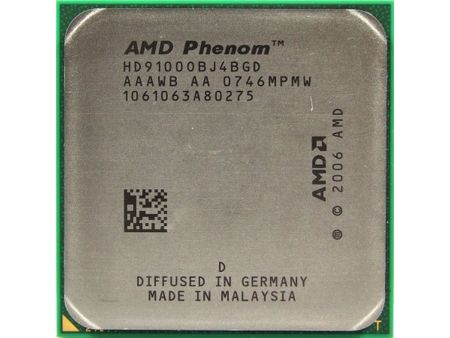The World's First 65 W Desktop Quad Core
Introduction
As far as performance is concerned, AMD is lagging behind its competitor Intel. But few users other than gamers still care solely about performance. In this age of burgeoning energy prices, AMD has an ace up its sleeve: the world’s first quad core CPU that consumes as little as 65 W (TDP). In comparison, Intel’s smallest quad core absorbs 95 W (TDP), despite the fact that Intel is already using 45 nm technology and AMD is still at 65 nm.
In terms of power consumption, AMD’s platform as a whole — motherboard, CPU and graphics chip — is not bad either. Its performance is perfectly adequate for office work and entertainment, though not for games. The integrated graphics engine in the 780G chipset is capable of rendering Blu-ray movies in 1920 HD resolution under maximum CPU load without jitter via HDMI. With Intel, this is only possible with a separate graphics card, as a comparable platform is not yet available.
AMD still has difficulties with high clock frequencies. While Intel’s quad core easily touches the 3 GHz mark, AMD is barely capable of 2.5 GHz. The Phenom X4 9100e presented in this article operates at 1.8 GHz.
Compared to classic Athlon 64 X2 CPUs, the first Phenom models with the B2 stepping featured improved power efficiency, but due to a TLB error — largely irrelevant in practice — the maximum clock rate had to be limited to 2.30 GHz. The B3 stepping eliminated the error, allowing the clock rate to be pushed up to 2.50 GHz. As even the B3 update failed to provide a major boost to the clock rate of the Phenom core, AMD was forced to increase the core voltage. Thus, the Phenom X4 with the B3 stepping is characterized by an extremely high power consumption (TDP) of 125 W.
Nevertheless, Tom’s hardware test of Phenom X3 CPUs provides evidence that AMD is capable of reducing the Phenom’s power consumption by optimizing the production process. Using a core based on the B3 stepping, the voltage and current requirements are much lower compared to the quad-core models at the same clock rate.
The following sections will shed light on how AMD was able to set the bar at 65 W.
Get Tom's Hardware's best news and in-depth reviews, straight to your inbox.
-
custommadename People can still play games with this quad core. Sure, it's not as fast as a quad core from Intel, but it's evidently more than suitable to handle today's games. However, for about $200 it's a horrible value.Reply -
Just a quick question... at 1.8GHz is this chip even competitive with a higher speed dual core (even when considering 4 core vs 2 and considering multi-core optimized applications)?Reply
It'd be interesting to add in a Intel mid to high range dual core and look at the power consumption and performance vs the relatively low clocked quad. Dropping the clockspeed so low would seem to give back most of the games from having 2 extra cores (and would be worse for SW that cannot use 4 cores). -
JSP78 Im an Q9450 owner and to just drop the multipler on the QX9770 and use the same vid isent fair.Reply
My Q9450 VID = 1.1v, EIST drops VID to 1.0375v
C1 stepping, slawr l806a762
I bet thats gonna make it hard for the phenom to beat -
thuan Page 12 title is wrong. It's 9.8% not 8.8%. Just mention it, as it seems no one's noticed it yet.Reply -
royalcrown This just goes to show how crappy "Barceloney" really is.Reply
Consider the fact that one can buy an e8400 or 8500 which uses the same power, can keep up with AMD's quad cores (even when they are over clocked), and also DESTROY this thing at gaming. WHY exactly would I buy this piece of crap again Frank ?!?!
I guess if I ran Cinebench benchmarks all day and did NOTHING else, then this cpu would look good.
People that buy quad cores are not going to care about 35 watts, they want to brag about speed OR get their work done ASAP, and AMD is crap for that right now ! -
Reynod An excellent review Frank ... well done.Reply
Very impartial ... showing the strength's and weaknesses of the low power unit.
The overclocking limit of 2.4 would be interesting to explore further.
Can you elaborate on what settings you went to ... and the HTT frequency please?
Cheers, -
Reynod An excellent review Frank ... well done.Reply
Very impartial ... showing the strength's and weaknesses of the low power unit.
The overclocking limit of 2.4 would be interesting to explore further.
Can you elaborate on what settings you went to ... and the HTT frequency please?
Cheers, -
OMA Why did you underclock the l3 cache and memory controller? The ht link is ment to be overclocked, not underclocked! L3 runs the same speed as ht link not 2,4 ghz. Slow L3 is a big bottleneck in games.Reply -
skittle comparing power consumption of a 1.8ghz phenom with a stock q6600 and touting the phenom as the power consumption king is a very inaccurate conclusion. The articles here just keep getting worse and worse... seriously who hires these clowns?Reply
